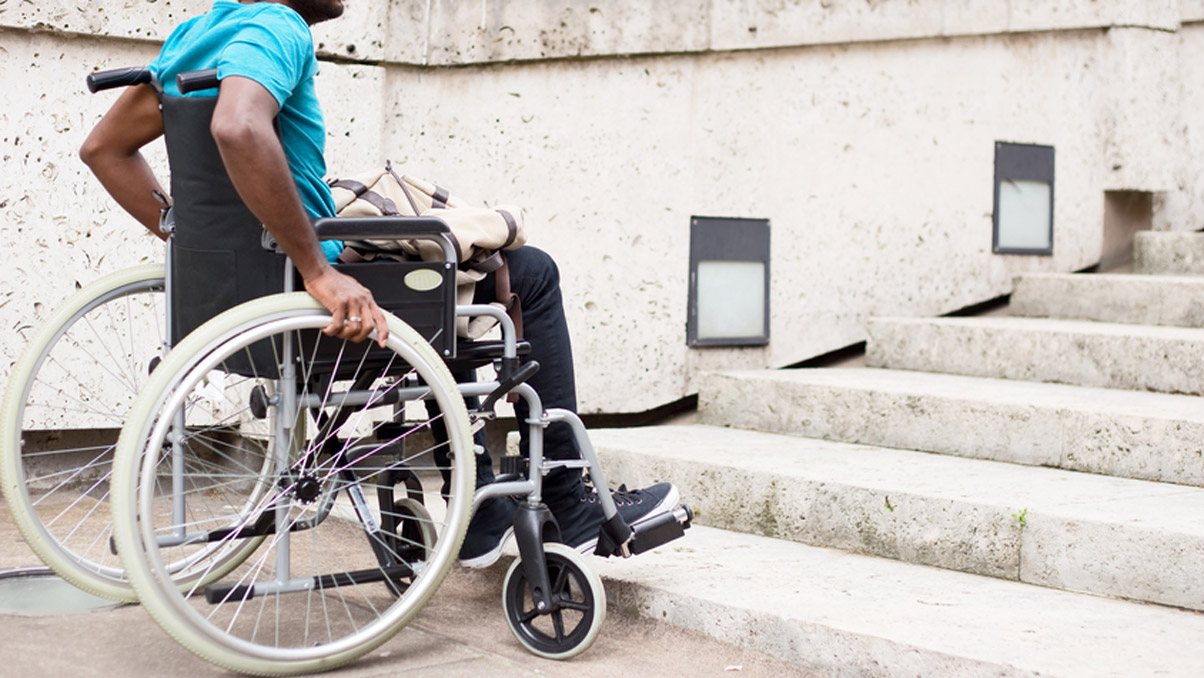The well documented ‘housing crisis’ in the UK refers to the housing gap created by a lack of affordable and suitable housing that is estimated to affect nearly 8.5 million people. Unfortunately, the national undersupply of housing for those who need it is magnified for disabled individuals. A review by the Equality and Human Rights Commission in 2018 revealed that a shocking 365,000 disabled people felt their home was not suitable for their needs, and included stories of people being trapped in their houses unable to access basic washing facilities.
A combination of a chronic shortage of suitable local authority housing and a lack of affordability and willingness to rent to people claiming disability benefits inherent in the private sector means that far too often patients find themselves in unsuitable accommodation. The result is that many disabled patients who have been discharged are stuck in inappropriate temporary accommodation, forced to rely on family and friends for accommodation or are discharged into a care home due to a lack of options. This has a detrimental impact not only on their recovery and rehabilitation but also on their mental health and independence.
We have assisted many disabled patients with housing issues as part of our Legal Service, and the shortage of suitable housing available is only too apparent. It is clear that without support the practical realities of searching for housing, (such as navigating online systems to bid for local authority housing, submitting medical evidence for priority banding or adaptions grants, and arranging to view private properties), can be overwhelming.
Below, I briefly outline the options available to patients who are able to be discharged home but whose current accommodation is no longer suitable in light of their disability. In some circumstances, an occupational therapist may be able to recommend adjustments that can be made to their current accommodation by way of adaptions funded by local authority grants or Disabled Facilities Grants. However, frequently this is not possible, leaving the patient in limbo with no suitable housing options as their discharge date looms.
Suitable local authority housing
A report by the Office for National Statistics in December 2019 highlighted how disabled people were more likely to rent social housing, with 24.7% of disabled people aged 16 to 64 years occupying these properties.
If a patient did not live in local authority housing prior to their injury or illness, they can apply to the housing register for their local council if they satisfy the eligibility criteria. Confusingly, every local authority has its own housing allocation policy, and it is necessary to check the housing allocation scheme on each local authority’s website to determine eligibility. An application to join the register needs to be supported by strong evidence about the patient’s medical and financial circumstances.
Alternatively, if a patient was previously living in local authority housing, but this housing is unsuitable, they will need to apply for a ‘transfer’ on these grounds, again providing supporting medical evidence.
The better the ‘banding’ awarded to the individual, the better chance they have of being awarded suitable housing in the shortest amount of time as they will be given priority over other bidders on Locata (An online website used by councils to allow prospective residents to bid on properties). Therefore, the more supportive medical evidence (such as occupational therapy reports) that can be provided for a patient, the better their chances of securing suitable accommodation. Unfortunately, as happens in many cases, if there is no suitable housing available the patient will often be either given the option of going into temporary accommodation paid for by the council or being temporarily placed in a nursing home until suitable housing is found.
Sadly, it is widely documented that this ‘temporary’ accommodation frequently becomes a long-term solution, with the council simply not having enough suitable properties to move disabled people into. Similarly, temporary placements at nursing homes often become long term for the same reason, with those able and willing to move into their own accommodation unable to do so.
Suitable housing in the private sector
Frequently, local authority housing registers will preclude individuals joining who do not have the required financial need or who have the means to rent privately and get help with their rent through housing benefit. If possible, this route offers a disabled individual a much quicker route to securing housing and can give them more flexibility on matters such as location.
Issues still persist with taking this route. Firstly, there is less wheelchair accessible housing to rent in the UK than there are wheelchair users in the UK. The Mayor of London’s London Plan 2004 made it a requirement for 10% of homes to be identified as wheelchair accessible or easily adaptable at the planning stage. As with many affordable housing targets, this has not been met consistently, and few housing developers are penalised for failing to provide the required number of suitable and affordable properties. Currently, only 1% of homes to be built outside London by 2030 are planned with accessibility for wheelchairs in mind.
However, useful designated accessible property websites (such as this tool for London) can aid in a search for suitable accommodation specific to the needs of the disabled person.
Shelter has reported that 63% of private landlords say they do not let or prefer not to let to people who receive housing benefit. With these kinds of policies in place, even if a disabled person can find suitable and accessible housing, many landlords may turn down their application on the fact that all or part of their income that will fund their rental payments is from welfare benefits.
What’s the good news?
While the current outlook may be bleak, there are some recent planning and legal changes that may go some way to alleviate the current situation.
A recent decision in a York court found a single mother had experienced indirect discrimination when a letting agent refused to rent to her on the basis that she was claiming housing benefit. The case was brought by Shelter as part of their ‘End DSS Discrimination’ campaign as they say these policies unfairly discriminate against women and disabled individuals as they are more likely to need to claim housing benefit.
‘No DSS’ policies refer to policies by landlords that preclude individuals claiming welfare benefits from renting, or put them at a disadvantage. The judge in the York case ruled ‘no DSS’ policies were in contravention of the Equality Act 2010 and amounted to indirect discrimination. Therefore, disabled individuals searching for suitable private rentals should be encouraged to challenge landlords who will not rent to them on this basis alone where they can demonstrate they can meet the rent.
Furthermore, awareness surrounding these issues and campaigns to rectify the current accessible and suitable housing shortage are gaining traction. Many more local authorities are making proposals and plans to incorporate suitable housing into future planning.
Conclusion
While it is hopeful that these changes may improve the situation for disabled individuals searching for housing, it is clear that more significant changes to the current system need to be made and delivered at a faster pace. With the NHS estimating that there are approximately 1.2 million wheelchair users in the UK, more needs to be done to make accessible housing available for those who need it most in both our private and public housing sectors.
We can assist individuals with a range of housing issues as part of the Legal Service and have assisted many patients in obtaining suitable housing following serious injury or illness. Also, the Equality and Human Rights Commission has produced useful and comprehensive guides on the rights of disabled individuals when it comes to finding housing which are easily accessible online.
This article was written by our Paralegal Emily Charlesworth.
The Legal Service – We are here to help
The Legal Service, delivered by our pro bono team, provides patients with advice without obligation, for however long it takes to resolve the issue. Our support is available regardless of the circumstances of an accident and regardless of whether a patient has a personal injury claim.
In these difficult times, the concerns of our pro bono clients are likely to be more stark than those in more fortunate circumstances. The Legal Service will be available throughout the crisis to help in any way we can to ease the burden on our clients.
To get advice from The Legal Service, please contact Kara Smith by phone on 020 7822 8000 or by email at ksmith@stewartslaw.com.
You can find further information regarding our injury expertise, experience and team on our Personal Injury pages.
Covid-19 is impacting individuals and companies around the world in an unprecedented way. We have collected insights here to help you navigate the key legal issues you may be facing at this time.
Subscribe – In order to receive our news straight to your inbox, subscribe here. Our newsletters are sent no more than once a month.







